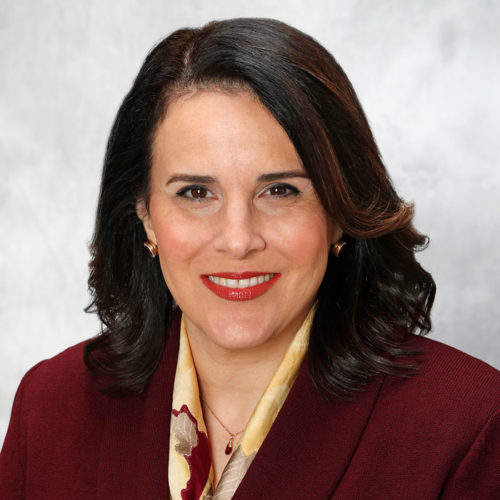
Quarterly Newsletter
Welcome to The American Talent Initiative quarterly newsletter – your source for news and insights on how we’re working toward our 50,000-by-2025 goal.
To read the full Summer 2020 newsletter, click here. You can read each of the Presidential Perspectives in full below.
Presidential Perspective: Ronald Crutcher, University of Richmond

Advancing Equity in Times of Crisis
The tragic murder of George Floyd, and the activism of hundreds of thousands of peaceful protesters thereafter, represents an inflection point in our history. At ATI, such a moment calls on us to deepen our commitment to our values & acknowledge how socioeconomic and racial equity are interconnected.
Q: What are the steps individual institutions can take to build on their progress toward these goals in the coming academic year?
We can be more mindful of, and account for, the external factors that may disproportionately impact our lower-income students, beginning with mental health. These unprecedented times may take a heavier toll on our lower-income students, who are not only concerned about their own well-being, but that of their own families.
That is why we are keenly focused on supporting the continued success of initiatives such as Spider Firsts, a cohort-based initiative that pairs first-generation students with student, faculty, and staff mentors committed to helping them navigate the college process and any barriers they may encounter. We are also opening a new Well-Being Center this fall, which will help students learn that success in college is not just about achieving a rich intellectual life, but also about equipping yourself to lead a happy, purposeful, and resilient life. We all need to be empowered to find our own equilibrium when life inevitably knocks us off balance.
Finally, this support can even extend to ensuring our students receive the nutrition they need, given some of the lowest-income students may sacrifice three meals a day for cheaper food plans so that they can send money home. By providing aid packages that include required meal plans with unlimited dining access, we can help ensure that students are not choosing between feeding themselves or their families. We must also be sensitive to the reality that some of our lower-income students do not have the ability to go home during periods when campus dining is closed, such as during Thanksgiving and winter break. Creating programs that provide stipends for food during these periods help bridge students across semesters.
Q: What will it take as a field to maintain commitments to the goals we have set as an initiative to improve access and success for lower-income students?
We must double down on our commitments to ATI goals given that the pandemic has triggered the worst financial crisis since the Great Depression and created some of the most difficult circumstances lower-income students and their families have ever known. We can continue to build on short-term measures such as payments to students for the hours they would have worked – and to pay regular full, part-time, and limited term non-exempt employees based on their regularly scheduled hours for as long as possible.
For long-term planning, we will continue to look to our Institutional Coordinating Council (ICC), which has provided the university’s leadership with a framework to weave diversity, equity, and inclusion priorities through our decision-making process. This helps ensure we carefully consider the lived realities of our most vulnerable community members and approach this moment as an opportunity to advance equity. For context, the ICC’s framework stems from our “Making Excellence Inclusive” report, which outlines three overarching goals: representation, belonging, and capability. This third goal of fostering a skilled intercultural community in which members are capable of bridging differences is something we did not fully pursue during the Civil Rights Movement but, as this national reckoning with racism reminds us, is more important now than ever.
Q: How can institutions also use the collective platform and mission of ATI to address systemic racism?
As someone who lived through the Civil Rights Movement, with the 1968 protest in Cincinnati starting right down the street on which I lived, I have seen both a lot of progress and setbacks in the quest to build a more just and equal America. But the tragic murder of George Floyd – and the activism of hundreds of thousands of peaceful protestors thereafter – seems like an inflection point in our history. At ATI, such a moment calls on us to deepen our commitment to our values and acknowledge how socioeconomic and racial equity are interconnected.
Moreover, in each interaction I have with groups across campus, I take time to discuss the national implications of this moment and outline how we can all do more to cultivate an anti-racist community. One of our big jobs as educators is to ensure our students have the capacity to interact with each other in authentic, honest, and direct ways on a regular basis across race, class, cultural, and ideological divides. Indeed, the four years students spend on our campuses may be their last opportunity to learn how to have such conversations. If not now, when?
Presidential Perspective: Joan Gabel, University of Minnesota

Advancing Equity in Times of Crisis
ATI's collective voice brings important visibility to issues of educational equity—and the commitment that leading institutions need to undertake to address them. The Initiative's work to facilitate and share best practices can enable all institutions to improve enrollment and retention of lower-income students.
Q: What are the steps individual institutions can take to build on their progress toward these goals in the coming academic year?
Individual institutions can build strong pipelines to the K-12 community, improve educational equity by reducing graduation gaps between low-income & higher-income students, expand affordability by increasing the number of low- and middle-income students whose tuition charges are completely covered by gift aid; and invest in measures to increase retention/graduation rates.
As a result, the University of Minnesota Twin Cities' four-year graduation rates for incoming Pell recipient freshmen have more than doubled in the past decade. Over the same period, six-year graduation rates for those students have increased by nearly 20 percentage points, with graduation rate gaps narrowing considerably (from 19.39% to 12.16% within four years and from 11.36% to 7.97% within six years).
And since 2012, we have successfully increased the number of Minnesota-based freshmen with tuition charges fully covered by gift aid by nearly 20 percentage points, an investment that has paid significant dividends for our institution.
The University of Minnesota is also committed to centering the voices and experiences of our Black communities, Indigenous populations, and communities of color to dismantle systemic racism—and to applying our expertise, resources, and abilities to drive action that is sustainable and has meaning. This work is ongoing with a focus on shared governance.
Q: What will it take as a field to maintain commitments to the goals we have set as an initiative to improve access and success for lower-income students?
ATI’s collective voice brings important visibility to issues of educational equity—and the commitment that leading institutions need to undertake to address them. The Initiative's work to facilitate and share best practices can enable all institutions to improve enrollment and retention of lower-income students.
Ultimately, ATI institutions need to redouble efforts to increase financial support for our low-income students.
To this end, at the University of Minnesota, we have just established a $15 million Bentson Challenge, with the support of a gift from the Bentson Foundation. The grant will help us match that $15 million investment, an effort explicitly devoted to advancing equity and opportunity on our campus. What this enables us to do is to provide up to a possible $45 million in increased support for our low-income students. We envision this concept will allow us to cover Pell-eligible students up to the full cost of attendance, a significant step toward realizing the goals we have set as an ATI member.
This important work is also part of a larger goal through our University’s new MPact 2025 systemwide strategic plan to reduce financial barriers to student achievement, and more particularly, to increase aid targeted to students with demonstrated need.
Q: How can institutions also use the collective platform and mission of ATI to address systemic racism?
Institutions can leverage the primary goal of ATI—to provide support for low-income and first-generation students—to help ameliorate the consequences of systemic racism.
While data informs us that low-income students come from a variety of backgrounds and contexts, we find that students of color here at the University of Minnesota Twin Cities are more than three times as likely to have low family incomes (as measured by the proportion of these students that receive Pell grants) and more than two-and-a-half times as likely to be the first in their family to attend college than other domestic students.
Therefore, we find that other programs—dedicated to promoting racial equity—are necessary to address the broader range of experiences and consequences faced by students of color at a predominantly white institution. Elevating ATI members’ initiatives can represent a critical starting point.
The American Talent Initiative
Author
-

The American Talent Initiative (ATI) is a Bloomberg Philanthropies-supported collaboration between the Aspen Institute's College Excellence Program, Ithaka S+R, and a growing alliance of colleges and universities dedicated to substantially expanding opportunity and access for low- and moderate-income students. ATI members—all graduating at least 70 percent of their students within six years—have joined together to address this challenge.
View all posts






